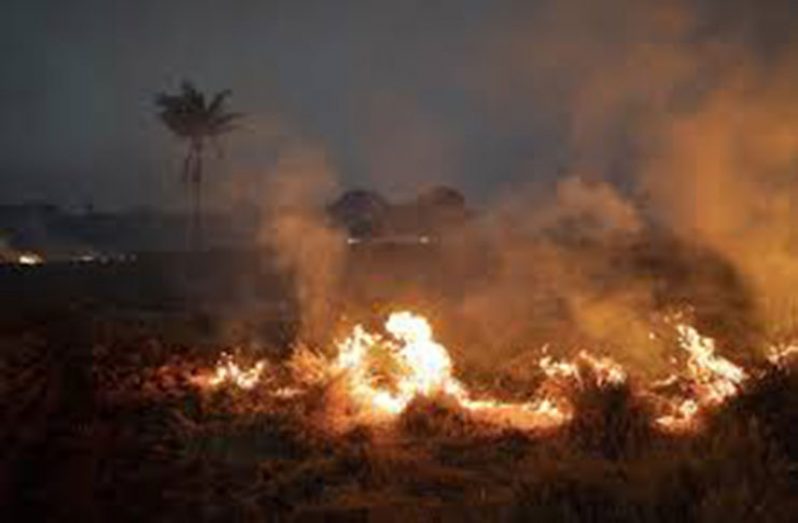…DoE says in expressing grave concern over situation
AS the world watches on in dismay at fires burning in the Amazon, the situation can potentially impact the Rupununi district here, according to the Department of Environment.
In a statement on Friday, August 30, 2019, the department said that Guyana remains “exceedingly concerned” about the fires in Brazil since the Amazon Basin is directly connected to Guyana’s natural environment. “The fires may potentially impact the Rupununi district where seasonal rainfall floods a vast savanna,” the department stated. It noted that countries in the Guiana Shield, Amazonia, academia, civil society and all stakeholders must work closely to strengthen forest conservation efforts in the Region.
According to the department, during the rainy season, the inundated Rupununi savannah allows a connection between the Amazon and Essequibo Rivers that provides the potential for annual exchange of fishes. This connection is referred to as the Rupununi portal, the unit said. However, it was noted that if the Amazon continues to burn, then there is a high probability that it will impact on the connectivity of this portal and decrease the animals using it, especially fish species.
Guyana is one of only thirty three countries in the world that is classified as a High Forest Cover Low Deforestation country. It was noted that efforts such as the Guyana-Norway Agreement and government’s commitment to prioritise the protection of the country’s rainforest through the ‘Green State Development Strategy: Vision 2040’, supports the country’s sustainable forest management ideal.
The Amazon is the world’s largest rainforest. It stretches across 5.5 million square kilometres, covering 40 per cent of the South American continent. It is often referred to as the lungs of the earth and one of earth’s best defence against climate change.
“This tragic event is a global emergency since no tract of the Amazon Rainforest can be treated in isolation of the entire Amazon forest as the benefits that the forest provides on a global scale are not restricted or limited by boundaries,” the department said. Consequently, it was noted that the Amazon fire is of direct concern to every country in the world, particularly the Amazonian countries which include Brazil, Bolivia, Colombia, Ecuador, Western Guyana, Peru, Suriname and Venezuela.
Among its uniqueness, the Amazon produces 20 per cent of the world’s oxygen and serves as a massive carbon sink. It also holds a plethora of ecosystems housing 10 per cent of the world’s known species of organisms that hold environmental, economic and social (health) benefits. Additionally, it is responsible for sustaining the livelihoods of many, including the Indigenous Communities that reside in the forest.
CAUSES OF THE FIRE OUTBREAKS
According to the department, the National Institute of Space Research noted that the number of fire outbreaks in the Brazilian Amazon region has increased by 84 per cent compared to the same period last year. It attributed the cause to several factors. Those listed include illegal deforestation as a result of land clearing and preparation for cattle ranching and agriculture, causing the Amazon to become drier, making it more susceptible to wildfires and for fire that are deliberately set to spread quicker.
REAL AND PRESENT DANGER
The department said that forests are custodians of a wide diversity of ecosystems, rich biodiversity and a large proportion of the world’s forest carbon for the benefit of all humanity. As a result of this, several legally-binding Multilateral Environmental Agreements places intact forest at the centre of the fight against climate change. The Convention on Biological Diversity (CBD) and the Paris Agreement under the United Nations Framework Convention on Climate Change for example recognises the exceptional importance of primary forest and the urgent necessity to avoid major fragmentation, damage and loss of primary forests of the planet as forest loss would reduce the capacity of ecosystems to store carbon and this in turn would lead to increases in greenhouse emissions.
IMPLICATIONS FOR THE AMAZON BASIN
The burning of the Amazon has deleterious consequences for the world. As the fire rages on, more wildlife habitats and biodiversity will be destroyed and many more species of wildlife, some of which are endemic to this location would be displaced. Further, animals are expected to migrate to areas that are not affected by the fire essentially putting stress on both the displaced wildlife and the wildlife that is already in that location, due to competition for available food, water and shelter.
The Indigenous People who occupy the Amazon Rainforest are expected to be impacted the hardest as they depend on the forest resources for food and shelter. This unwelcomed event will also pose serious risks to their health through smoke inhalation. Already, the accumulation of smoke is affecting residents of areas outside of the rainforest such as Sao Paulo.
IMPLICATIONS ON GLOBAL CLIMATIC CONDITIONS
As a result of this catastrophe, an exponential amount of carbon dioxide is being emitted to the atmosphere which, no doubt, will aggravate the impacts of climate change. As a result, it is likely that the world’s focus on limiting greenhouse gas increases to 1.5 Degrees Celsius by 2050 may be in jeopardy.
Also, with the loss of so many trees, it is envisaged that there will be a decrease in evapo-transpiration, thus reducing the amount of precipitation in South America. Important to note is that both cities and rural communities depend on these sources of atmospheric water and may potentially be faced with economic and ecological consequences.



.jpg)








